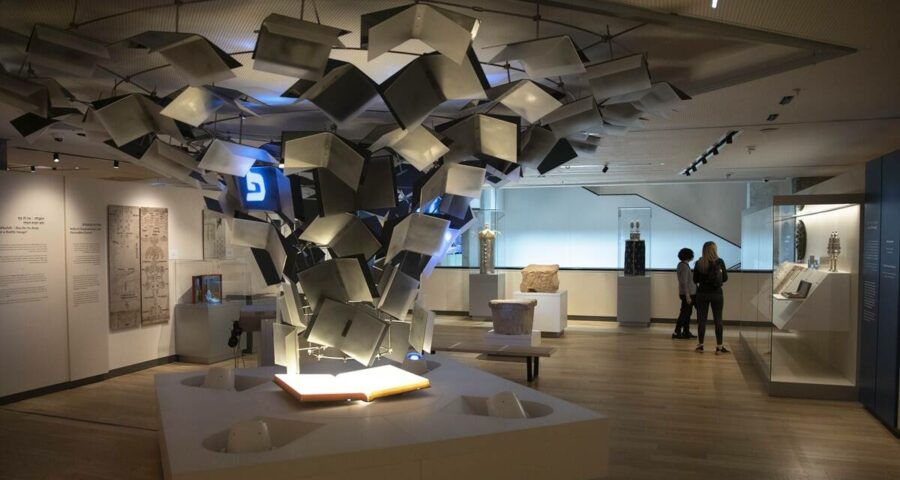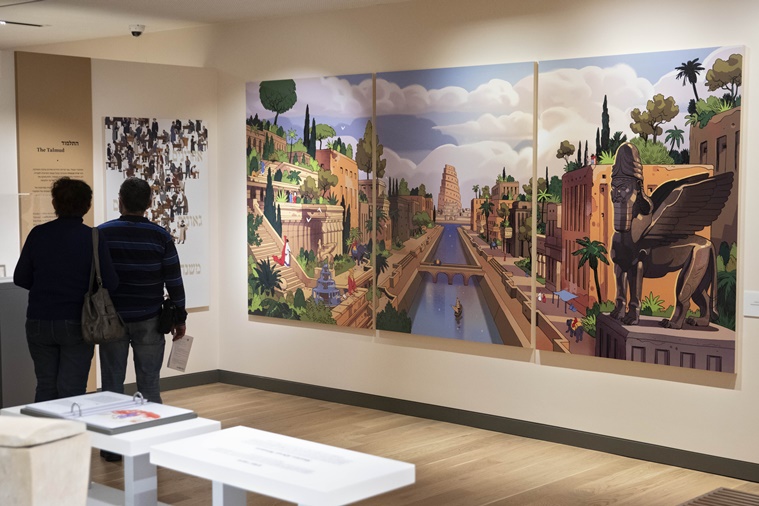A major draw is the original artwork highlighting lesser-known historical figures such as Ottoman Jewish philanthropist Dona Gracia Mendes Nasi and the legendary Ethiopian warrior queen Yodit. Visitors can use a digital bracelet to capture memorable elements — from literary quotations, to recipes and family trees — and take them home by email
From Queen Salome to the late RBG, from Moses to Sandy Koufax, Tel Aviv’s newly revamped Museum of the Jewish People attempts the ambitious undertaking of bringing almost 3,000 years of Jewish history and tradition under a single roof.
The museum — formerly known as Beit Hatfutsot and newly branded as ANU, Hebrew for “We” — reopened to visitors this week after more than a decade of renovations costing $100 million.
Its exhibition space has tripled, making it the largest Jewish museum in the world, officials say. Its old galleries with dioramas and models from when it first opened in 1978 have given way to cutting-edge exhibits with interactive touchscreens and original artwork.
Close to a third of the renovation was financed by the Nadav Foundation of Russian-Israeli Leonid Nevzlin, a former oil magnate. Another USD 52 million came from other U.S.-based philanthropists and foundations, and $18 million from the Israeli government. Nevzlin’s daughter Irina, the wife of Israeli Health Minister Yuli Edelstein, serves as chair of the museum’s board of directors.
The refurbished museum adopts a fresh approach to telling the story of the Jewish people, said chief curator Orit Shaham-Gover. It focuses on the diversity of Jewish culture and the accomplishments of the Jewish people, not just its tragedies, she said.
“Everyone walking in here needs to see themselves regardless of gender, denomination, ethnic background,” said Dan Tadmor, the museum’s CEO. “This is our story and you need to feel part of it.”
Scattered through 72,000 square feet (6,690 square meters) of galleries are historical artifacts and mementos: a jawza — a type of stringed instrument — belonging to 20th-century Iraqi musicians known as the Al-Kuwaity brothers, one of late Supreme Court Justice Ruth Bader Ginsburg’s signature collars, a Book of Esther scroll from pre-Inquisition Spain, and a monumental carved stone from a first-century A.D. synagogue on the shores of the Sea of Galilee.
A major draw is the original artwork highlighting lesser-known historical figures such as Ottoman Jewish philanthropist Dona Gracia Mendes Nasi and the legendary Ethiopian warrior queen Yodit. Visitors can use a digital bracelet to capture memorable elements — from literary quotations, to recipes and family trees — and take them home by email.
Shaham-Gover, the curator, said the open-space gallery of contemporary Jews is “a celebration of life and culture and lights and colors.”
“The museum is not a muted temple,” she said. “It’s about life. So you come here, you have sounds, you have light and colors. It’s part of you.” Its grand opening comes as the fundamental issue of who is a Jew has resurfaced in Israeli politics ahead of this month’s fourth parliamentary election in two years.
The Supreme Court recently ruled that people who had undergone Reform and Conservative conversions to Judaism in Israel would qualify as Jews when applying for citizenship under Israel’s Law of Return. The decision has outraged Israel’s powerful ultra-Orthodox religious establishment, which has long held a monopoly over conversions, along with members of the ruling Likud party.
Upon entering the main gallery, visitors encounter life-sized projections of Jews from a kaleidoscope of different affiliations and lifestyles — from Reform to ultra-Orthodox and everything in between — explaining how they define their Jewish identity.
Anat Lieberman, a museum visitor from the town of Ramat Gan, said the presentation of people from “all colors of the rainbow” was moving, and showed that it was a museum “for the entire Jewish people.” Tadmor avoided touching on the politics of the issue and insisted the institution does not take a stance on the question of who is a Jew.
“We’re nonpolitical. We don’t favor any denomination. We’re floating 20,000 feet above all of that,” he insisted. “We just want to make sure that everyone is represented and you don’t come out feeling like I’m transparent.’”
Source: Read Full Article



